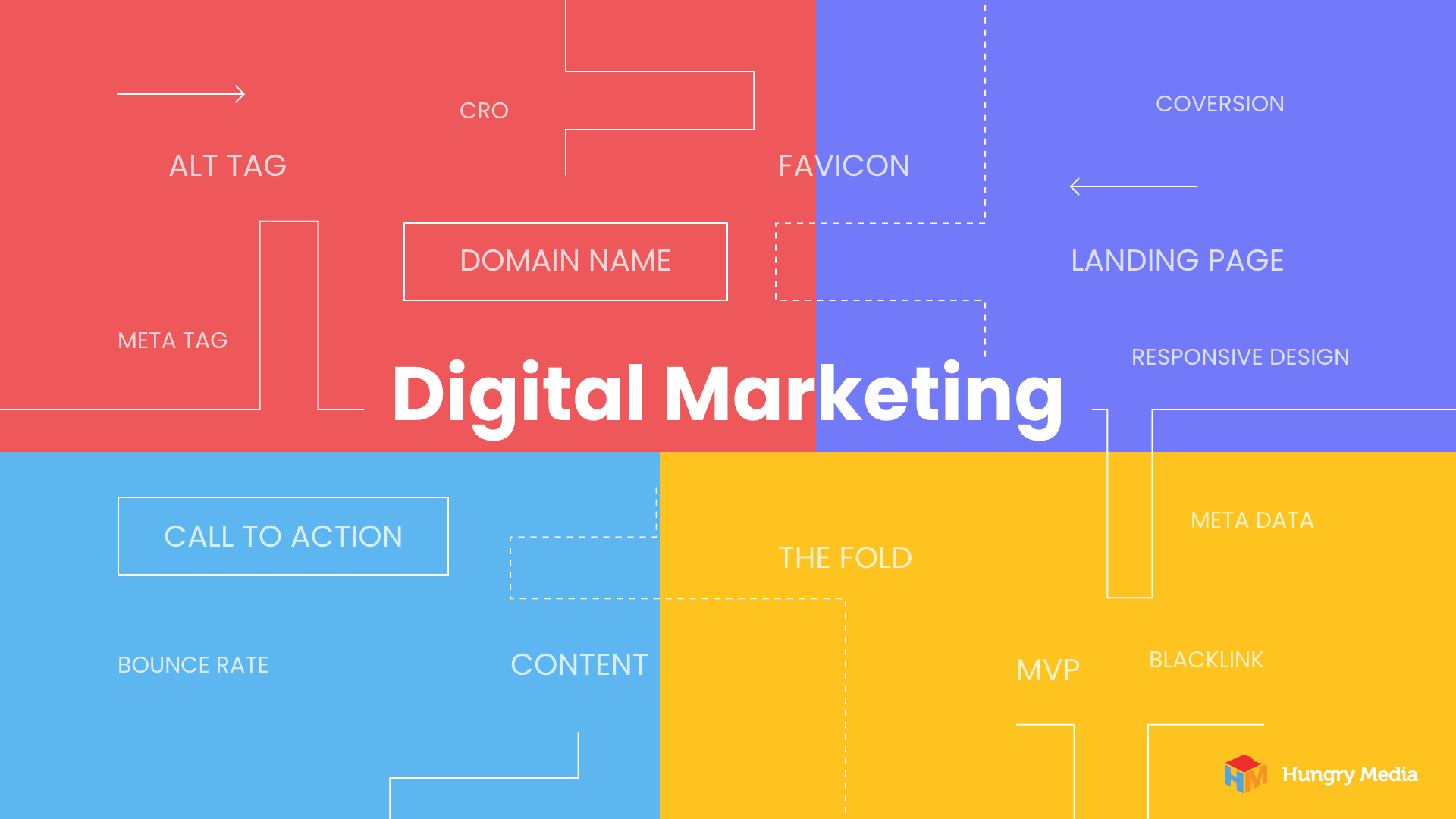
Designing and developing a website involves plenty of unfamiliar words and terms. While you don’t need to understand the nitty gritty, having a grasp on digital marketing terms is ideal for anyone embarking on a web design project. Here are the 15 most common digital marketing terms to know.
Alt Tag
An alt tag is also known as an alt attribute or alt description. Because search engines cannot interpret images, an alt tag is applied them, providing searchable text. When Google crawls a website, images with appropriately formatted alt tags contribute to the ways in which the site is indexed. Because of this, applying alt tags to images can positively impact search engine rankings.
Backlink
A backlink connects one website to another. Search engines use these links to help decide how well a particular website will satisfy a query. The thought is that frequent links to a particular webpage indicate that the page is of value. Sites providing greater value achieve higher rankings in search results.
Bounce Rate
It’s thought that if users visit a website but leave before taking action, they have not deemed that site to be of value. The digital marketing term “bounce rate,” describes this scenario. It’s the number of single-page visits to your website, as a percentage of all visits. It stands to reason that the lower the bounce rate, the more effective your website, making this one of the most common digital marketing terms to learn.
Call to Action
A call to action, or CTA, is part of a marketing campaign. It is a written directive that tells a user to take a specific action. In the context of digital marketing, CTAs almost always encourage users to click a link intended to move them through the sales process. A CTA might say something like “Register Now,” “Request Information,” or “Join our Mailing List.”
Conversion
Website conversion is the term used to describe a user taking an action that moves them through the sales process. Examples of a conversion include visiting a website and signing up for their email list, opening an email and clicking a link to a product, clicking a link to a product and adding it to your cart, and so on.
CRO
Conversion Rate Optimization, or CRO, encompasses a variety of marketing tools and methods to increase the number of conversions on a website. CRO marketing tends to focus on ways to capture as many users as possible, at any step of the sales process.
Content
Content is intended to engage users, and comes in many forms including social media posts, blogs, podcasts, and eBooks. It tends to be longer form and more frequently updated than typical marketing copy, as content aims to generate warm leads that could convert down the road. Not only does an effective content strategy play a role in SEO and CRO, but it serves to connect users to the brand.

Domain Name
Simply put, a domain name is the string of text we use to access a website. For instance, www.HungryMedia.com. However, as we now live so much of our lives online, domain names have come to represent an online identity. It’s often the first impression visitors have of a company or a brand, and like so many of our other terms used in digital marketing, it can also have an impact on SEO.
Favicon
This little icon is always noticed, but rarely considered. It’s the tiny icon next to the page name on a browser tab. It provides an easy visual representation of the website and brand, making it easy for a user to quickly navigate between browser tabs at a glance.
Landing Page
A landing page is often used in digital marketing. In basic terms it is a web page on which users “land” from another digital space. This space could be an email ad, social media post, list of search engine results, or any other online location. Landing pages are standalone pages created for a specific marketing campaign and encourage users to take a desired action such as clicking to learn more or providing contact information.
Metadata
Website metadata is attached to every individual page included in a website and provides a page title and description. It offers important information to search engines about the purpose and content of each webpage, helping to determine whether the page is relevant to the searcher’s query.
Meta Tag
Meta Tags are small snippets of text that describe the content contained within a web page. They don’t appear in the page, but rather in the source code. Search engines take information contained within meta tags into consideration when determining which websites to return in the results listing.
MVP
The most basic version of a new product, sans any bells and whistles, is called the Minimum Viable Product, or MVP. MVPs are essentially steppingstones that help determine whether a viable idea will translate to a viable product. It allows developers to collect data, gain an understanding of users’ needs, and share important information with potential investors before investing a significant amount of time or money in more detailed development.
Responsive Design
Have you ever noticed that the same website looks different on your laptop than your phone? Responsive design allows a website to adapt to the size of the screen on which it’s displayed. This is a relatively new approach to web design, but it’s very important in today’s digital world. Mobile-first design strategy always includes responsive design, as do most UX design strategies.
The Fold
The fold is among the digital marketing keywords taken from our pre-digital world. Picture a newspaper before it is unfolded by the reader. Everything visible on the top half of the front is literally located “above the fold.” This is a very desirable location for content and ads, as it provides maximum visibility. In the context of web design, the fold refers to the place at which a user must begin scrolling to see additional content. The location of the fold differs depending on the size of the screen on which the content is viewed, but the bottom line remains the same: the more important the content, the higher on the page it should be displayed.
Digital Marketing Made Easy with Hungry Media
You don’t have to be fluent in digital marketing terms to have a hand in creating an effective, aesthetically pleasing website. Hungry Media’s team of expert project managers, developers, and designers are the perfect partners whether you’re building a brand-new app, revamping a dated website, or anything in between. Contact us today to learn how we can help take your project to the next level. We can’t wait to meet you!
contributed by Melissa Lucas, senior staff writer
